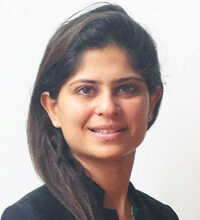
A guest post by MBA student Gundeep Kaur (WG’15).
It’s mid-September, and my four teammates and I are clustered around a computer in a Huntsman Hall study room. We’re here for the Mack Institute’s pilot Collaborative Innovation Program, and we’re about to find out what challenge we’re going to spend the rest of the semester tackling.
Over Skype, we hear CA Technologies’ VP of Product Marketing say, “My expectation is for the Philly team to come up with a Market Requirements Document in the Internet of Things (IoT) space.”
The five of us—three second-year MBA students, a first-year MBA student, and an Integrated Product Design undergrad—looked at each other across the room, wondering exactly what the ask was. At that moment, we weren’t quite sure where to begin. But inspired by recent developments in IoT, we were eager to research the space and collaborate to solve a real business problem.
The Project
We began by setting up a project plan that included weekly milestones. This was crucial in keeping us focused, even during times of recruiting, travel, or other school activities. The team’s energy was infectious. By using a divide-and-conquer approach, we identified new opportunities for the software company, both in horizontal and vertical industries. However, we still felt we were not quite hitting the nail on the head.
One day, I came upon an advertisement for CA World ’14, an annual conference for the company’s investors and customers. I immediately reached out to our sponsor and professor to ask if team members could attend the conference, and the Mack Institute kindly sponsored us for the event in Las Vegas. Excitedly, we saw the conference as an excellent opportunity to learn more about the industry.
“Through the Collaborative Innovation Program, I found a platform to put theory learned in class into practice.”
At the conference, we interviewed partners, clients, and competitors of the company. It was an eye-opener in terms of potential solutions that CA Technologies could implement with its partners. Upon return, we integrated our findings into our final deliverable and analyzed the fit of our solutions with the existing product suite. We came up with a strategic action plan for implementation and exceeded our sponsor’s expectations.
The Wharton Experience
Wharton’s motto of putting knowledge into action resonated with my personality from the first time I set foot onto campus. Whether it is academics or student-led activities, the energy and enthusiasm of making things happen permeates across the campus. Through the Collaborative Innovation Program, I found a platform to put theory learned in class into practice.
The ability to share unique perspectives and findings with cross-functional teammates was crucial to identifying profitable opportunities. I am now aware of the challenges faced by mature technology firms and the actions these companies take to enter disruptive markets. I learned about an entirely new industry – the Internet of Things. Most importantly, I learned the importance of putting oneself in the sponsor’s shoes before recommending a solution. As I prepare to lead teams and advise clients in my future professional life, I look forward to leveraging the knowledge and skills I have gained through the project.
Trying to figure out if CIP is for you? Read more from Gundeep’s classmate Wanhang Du, and from course instructor Charlotte Ren.
About the Author
 Gundeep Kaur took part in the pilot semester of the Collaborative Innovation Program, a class in which students work with Mack Institute corporate partners to gain experience addressing real industry challenges.
Gundeep Kaur took part in the pilot semester of the Collaborative Innovation Program, a class in which students work with Mack Institute corporate partners to gain experience addressing real industry challenges.
Gundeep is a second year MBA student majoring in Finance and Entrepreneurial Management. Prior to Wharton, Gundeep spent four and a half years at Barclays as Equity Derivatives Project Manager and Product and Marketing Strategist where she managed teams to develop cutting-edge technologies, launched new equity products and divested businesses. Gundeep holds Bachelors in Computer Engineering and Minor in Management from National University of Singapore and has spent a year at Silicon Valley taking technology entrepreneurship courses at Stanford and working in a start-up.



